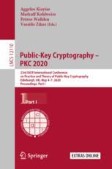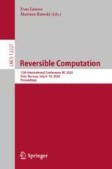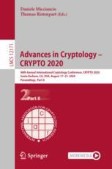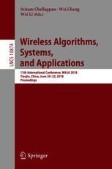Search
Search Results
-
Introduction to Authentication and Key Establishment
Authentication and key establishment are fundamental steps in setting up secure communications. Authentication is concerned with knowing that the...
-
Flexible Authenticated and Confidential Channel Establishment (fACCE): Analyzing the Noise Protocol Framework
The Noise protocol framework is a suite of channel establishment protocols, of which each individual protocol ensures various security properties of...
-
Hermes: A Language for Light-Weight Encryption
Hermes is a domain-specific language for writing light-weight encryption algorithms: It is reversible, so it is not necessary to write separate...
-
Many a Mickle Makes a Muckle: A Framework for Provably Quantum-Secure Hybrid Key Exchange
Hybrid Authenticated Key Exchange (AKE) protocols combine keying material from different sources (post-quantum, classical, and quantum key...
-
Actively Secure Arithmetic Computation and VOLE with Constant Computational Overhead
We study the complexity of two-party secure arithmetic computation where the goal is to evaluate an arithmetic circuit over a finite field...
-
ATLAS: Efficient and Scalable MPC in the Honest Majority Setting
In this work, we address communication, computation, and round efficiency of unconditionally secure multi-party computation for arithmetic circuits...
-
On Actively-Secure Elementary MPC Reductions
We introduce the notion of elementary MPC reductions that allow us to securely compute a functionality f by making a single call to a constant-degree...
-
Synchronization of the Quantum Key Distribution System with Priori Information About the Fiber-Optic Line Length
The synchronization is explored for the quantum key distribution (QKD), where photon pulses are utilized as synchronized signals. The analyzed...
-
Combining ProVerif and Automated Theorem Provers for Security Protocol Verification
Symbolic verification of security protocols typically relies on an attacker model called the Dolev-Yao model, which does not model adequately various...
-
QML: Way Forward
Quantum machine learning (QML) is a cross-disciplinary subject made up of two of the most exciting research areas: quantum computing and classical...
-
Guaranteed Output Delivery Comes Free in Honest Majority MPC
We study the communication complexity of unconditionally secure MPC with guaranteed output delivery over point-to-point channels for corruption...
-
Efficient Perfectly Secure Computation with Optimal Resilience
Secure computation enables n mutually distrustful parties to compute a function over their private inputs jointly. In 1988, Ben-Or, Goldwasser, and...

-
Beyond the Csiszár-Korner Bound: Best-Possible Wiretap Coding via Obfuscation
A wiretap coding scheme (Wyner, Bell Syst. Tech. J. 1975) enables Alice to reliably communicate a message m to an honest Bob by sending an encoding c...
-
Towards Accountability in CRS Generation
It is well known that several cryptographic primitives cannot be achieved without a common reference string (CRS). Those include, for instance,...
-
A Cooperative Jamming Based Secure Uplink Transmission Scheme for Heterogeneous Networks Supporting D2D Communications
A heterogeneous network supporting D2D communications is a typical framework to cope with data sharing in a cyber physical system. In the network,...
-
Optimal Security Notion for Decentralized Multi-Client Functional Encryption
Research on (Decentralized) Multi-Client Functional Encryption (or (D)MCFE) is very active, with interesting constructions, especially for the class...
-
Micro-Hypervisor Applications
This chapter showcases several micro-hypervisor-based applications (“uberapps”) that employ uberXMHF. These uberapps span a wide spectrum of security...
-
Provably Secure Proactive Secret Sharing Without the Adjacent Assumption
In secret sharing (SS), the secret is shared among a number of parties so that only a quorum of these parties can recover the secret, but a smaller...
-
Efficient Perfectly Secure Computation with Optimal Resilience
Secure computation enables n mutually distrustful parties to compute a function over their private inputs jointly. In 1988 Ben-Or, Goldwasser, and...
-
Watermarking techniques for medical data authentication: a survey
With the widespread growth of medical images and improved communication and computer technologies in recent years, authenticity of the images has...

